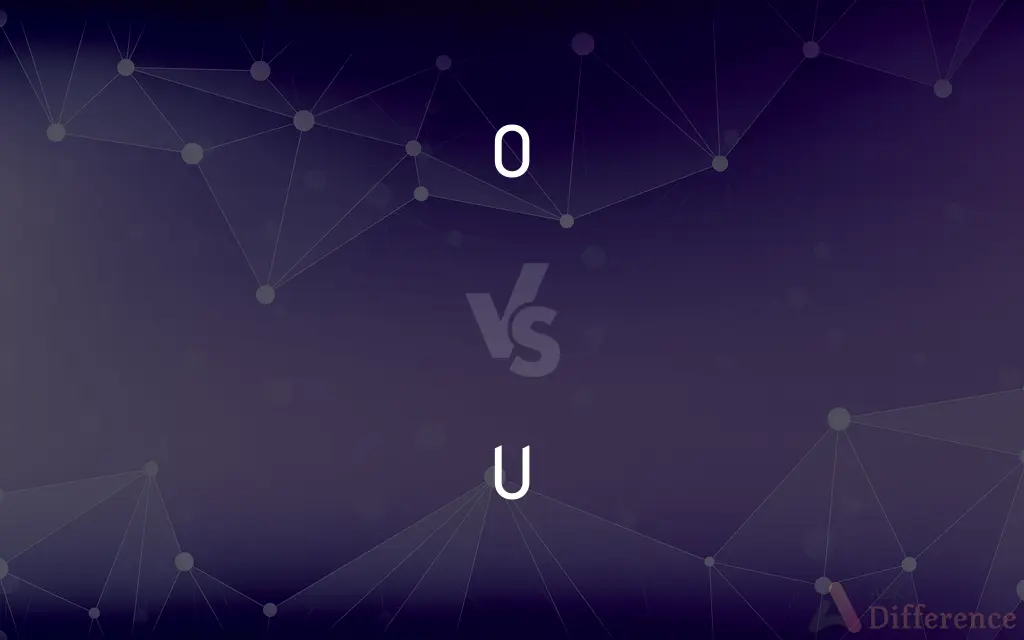O vs. U — What's the Difference?
By Tayyaba Rehman & Fiza Rafique — Updated on April 15, 2024
'O' and 'U' are vowels in the English alphabet with distinct phonetic sounds; 'O' can represent multiple sounds like /oʊ/ or /ɒ/, while 'U' often denotes /ʌ/ or /juː/.

Difference Between O and U
Table of Contents
ADVERTISEMENT
Key Differences
'O' is versatile in its pronunciation, appearing in words such as "not" (/ɒ/) and "go" (/oʊ/), showcasing its range in vocal expression. In contrast, 'U' has distinct uses, such as in "cup" (/ʌ/) and "mute" (/juː/), providing a different set of phonetic challenges and variability.
While 'O' often forms the phonetic sounds /oʊ/ in "bone" or /ɒ/ in "pot," it also appears in diphthongs like /aʊ/ in "out." On the other hand, 'U' can express the sound /ʊ/ as in "pull" and occasionally appears in diphthongs such as /aɪ/ in "cuisine."
In terms of spelling, 'O' can be silent or change its sound due to the surrounding letters, as seen in "one" (/wʌn/) or "women" (/ˈwɪmɪn/). 'U', however, is usually more consistent but can also be silent, especially in words borrowed from French, like "gourmet" (/ˈɡʊərmeɪ/).
'O' is used in some spelling conventions to indicate a long vowel sound in the preceding letter, as in "mode" or "home." Conversely, 'U' is often used to soften the 'g' or 'c' before it, turning into a /j/ sound, as seen in "guitar" or "cute."
'O' can represent zero in certain contexts, which is a unique numerical usage not shared by 'U'. 'U', instead, is commonly used as an abbreviation in informal writing and texting, representing the word "you."
ADVERTISEMENT
Comparison Chart
Phonetic Sounds
/oʊ/, /ɒ/, /aʊ/
/ʌ/, /juː/, /ʊ/, /aɪ/
Examples
"go" (/oʊ/), "not" (/ɒ/)
"cup" (/ʌ/), "mute" (/juː/)
Diphthongs
/aʊ/ as in "out"
/aɪ/ as in "cuisine"
Silent Usage
"one" (/wʌn/), "colonel" (/ˈkɜrnəl/)
"gourmet" (/ˈɡʊərmeɪ/), "guest"
Special Usage
Represents zero
Abbreviates "you" in text
Compare with Definitions
O
A vowel with multiple phonetic sounds.
In note, 'O' is pronounced as /oʊ/.
U
A vowel represented by sounds like /ʌ/ or /juː/.
In cut, 'U' is pronounced as /ʌ/.
O
Can indicate long vowel sounds.
The 'O' in stone signals a long /oʊ/.
U
Often softens the preceding 'g' or 'c'.
In guitar, 'U' influences the pronunciation to /ɡɪˈtɑr/.
O
Sometimes silent in words.
The 'O' in colonel is not pronounced.
U
Used informally as an abbreviation for "you".
In texts, 'U' is commonly used to mean you.
O
Represents zero in alphanumeric contexts.
'O' is often used to denote zero in serial codes.
U
Can be silent, especially in French loanwords.
'U' is silent in the word gourmet.
O
Appears in various diphthongs.
In about, 'O' is part of the diphthong /aʊ/.
U
Appears in diphthongs occasionally.
The 'U' in suit contributes to the /juː/ sound.
O
O, or o, is the fifteenth letter in the ISO basic Latin alphabet and the fourth vowel letter in the modern English alphabet. Its name in English is o (pronounced ), plural oes.
U
U, or u, is the twenty-first and sixth-to-last letter of the ISO basic Latin alphabet and the fifth vowel letter of the modern English alphabet. Its name in English is u (pronounced ), plural ues.
O
Used before the name of or a pronoun referring to a person or thing being formally addressed
"How can I put it to you, O you who prepare to travel with important matters on your mind?" (Jo Durden-Smith).
U
Chiefly British Of or appropriate to the upper class, especially in language usage.
O
Used to express surprise or strong emotion
"O how I laugh when I think of my vague indefinite riches" (Henry David Thoreau).
U
The 21st letter of the modern English alphabet.
O
The 15th letter of the modern English alphabet.
U
Any of the speech sounds represented by the letter u.
O
Any of the speech sounds represented by the letter o.
U
The 21st in a series.
O
The 15th in a series.
U
Something shaped like the letter U.
O
Something shaped like the letter O.
U
U A grade that indicates an unsatisfactory status.
O
A zero.
U
Used as a courtesy title before the name of a man in a Burmese-speaking area.
O
Of
Lots o' luck.
Top o' the morning.
U
A thing in the shape of the letter U
O
Alternative form of oh
U
Abbr of underwater
O
Operator
U
The twenty-first letter of the English alphabet, is a cursive form of the letter V, with which it was formerly used interchangeably, both letters being then used both as vowels and consonants. U and V are now, however, differentiated, U being used only as a vowel or semivowel, and V only as a consonant. The true primary vowel sound of U, in Anglo-Saxon, was the sound which it still retains in most of the languages of Europe, that of long oo, as in tool, and short oo, as in wood, answering to the French ou in tour. Etymologically U is most closely related to o, y (vowel), w, and v; as in two, duet, dyad, twice; top, tuft; sop, sup; auspice, aviary. See V, also O and Y.
O
(acronym of) Object, see SVO
U
A nitrogen-containing base found in RNA (but not in DNA) and derived from pyrimidine; pairs with adenine
O
A zero used in reading out numbers.
It is currently two-o-five in the afternoon (2:05 PM).
The first permanent English settlement in America was in Jamestown in sixteen-o-seven (1607).
U
A heavy toxic silvery-white radioactive metallic element; occurs in many isotopes; used for nuclear fuels and nuclear weapons
O
Over
U
The 21st letter of the Roman alphabet
O
O, the fifteenth letter of the English alphabet, derives its form, value, and name from the Greek O, through the Latin. The letter came into the Greek from the PhŒnician, which possibly derived it ultimately from the Egyptian. Etymologically, the letter o is most closely related to a, e, and u; as in E. bone, AS. bān; E. stone, AS. stān; E. broke, AS. brecan to break; E. bore, AS. beran to bear; E. dove, AS. dūfe; E. toft, tuft; tone, tune; number, F. nombre.
U
(chiefly British) of or appropriate to the upper classes especially in language use
O
Among the ancients, O was a mark of triple time, from the notion that the ternary, or number 3, is the most perfect of numbers, and properly expressed by a circle, the most perfect figure.
O
The letter O, or its sound.
O
Something shaped like the letter O; a circle or oval.
O
A cipher; zero.
Thou art an O without a figure.
O
One.
O
An exclamation used in calling or directly addressing a person or personified object; also, as an emotional or impassioned exclamation expressing pain, grief, surprise, desire, fear, etc.
For ever, O Lord, thy word is settled in heaven.
O how love I thy law ! it is my meditation all the day.
O for a kindling touch from that pure flame!
But she is in her grave, - and ohThe difference to me!
Oh for a lodge in some vast wilderness!
We should distinguish between the sign of the vocative and the emotional interjection, writing O for the former, and oh for the latter.
O
A nonmetallic bivalent element that is normally a colorless odorless tasteless nonflammable diatomic gas; constitutes 21 percent of the atmosphere by volume; the most abundant element in the earth's crust
O
The 15th letter of the Roman alphabet
Common Curiosities
What are the common sounds associated with 'O'?
'O' can represent sounds like /oʊ/ in "no" or /ɒ/ in "not."
What are the common sounds associated with 'U'?
'U' commonly denotes sounds such as /ʌ/ in "up" and /juː/ in "use."
How is 'O' used in spelling?
'O' can indicate a long vowel sound or appear in diphthongs and sometimes is silent.
Can 'O' and 'U' be silent?
Yes, both 'O' and 'U' can be silent in specific words like "colonel" for 'O' and "guest" for 'U'.
What does 'U' commonly abbreviate in informal writing?
'U' is often used as an abbreviation for the word "you" in texting.
What are examples of 'O' in diphthongs?
'O' appears in diphthongs like /aʊ/ in "out."
Do 'O' and 'U' appear in silent forms?
Both vowels have silent occurrences in specific words, contributing to the complexity of English spelling.
How is 'U' used in spelling?
'U' can soften the 'g' or 'c' that precedes it and is used in diphthongs, or can be silent in some words.
Is 'O' used to represent numerical values?
Yes, 'O' can represent zero in certain contexts, such as serial numbers.
How does the usage of 'O' and 'U' differ in American and British English?
Pronunciations and usages can vary, particularly in vowel sounds and the treatment of 'r' following these vowels.
What are examples of 'U' in diphthongs?
'U' contributes to diphthongs like /aɪ/ in "cuisine."
What unique roles do 'O' and 'U' play in the English language?
'O' uniquely represents zero, while 'U' is used informally to abbreviate "you."
What challenges do 'O' and 'U' present in phonetics?
Both vowels offer a range of sounds and can be challenging in terms of pronunciation and spelling.
What should learners remember about the vowels 'O' and 'U'?
Learners should note the multiple sounds and roles both vowels play in the English language, along with their occasional silent usage.
Can 'O' and 'U' change their pronunciation based on location?
Yes, the pronunciation can vary significantly based on dialect and the surrounding letters.
Share Your Discovery

Previous Comparison
Invoke vs. Call
Next Comparison
Passion vs. TenderAuthor Spotlight
Written by
Tayyaba RehmanTayyaba Rehman is a distinguished writer, currently serving as a primary contributor to askdifference.com. As a researcher in semantics and etymology, Tayyaba's passion for the complexity of languages and their distinctions has found a perfect home on the platform. Tayyaba delves into the intricacies of language, distinguishing between commonly confused words and phrases, thereby providing clarity for readers worldwide.
Co-written by
Fiza RafiqueFiza Rafique is a skilled content writer at AskDifference.com, where she meticulously refines and enhances written pieces. Drawing from her vast editorial expertise, Fiza ensures clarity, accuracy, and precision in every article. Passionate about language, she continually seeks to elevate the quality of content for readers worldwide.














































